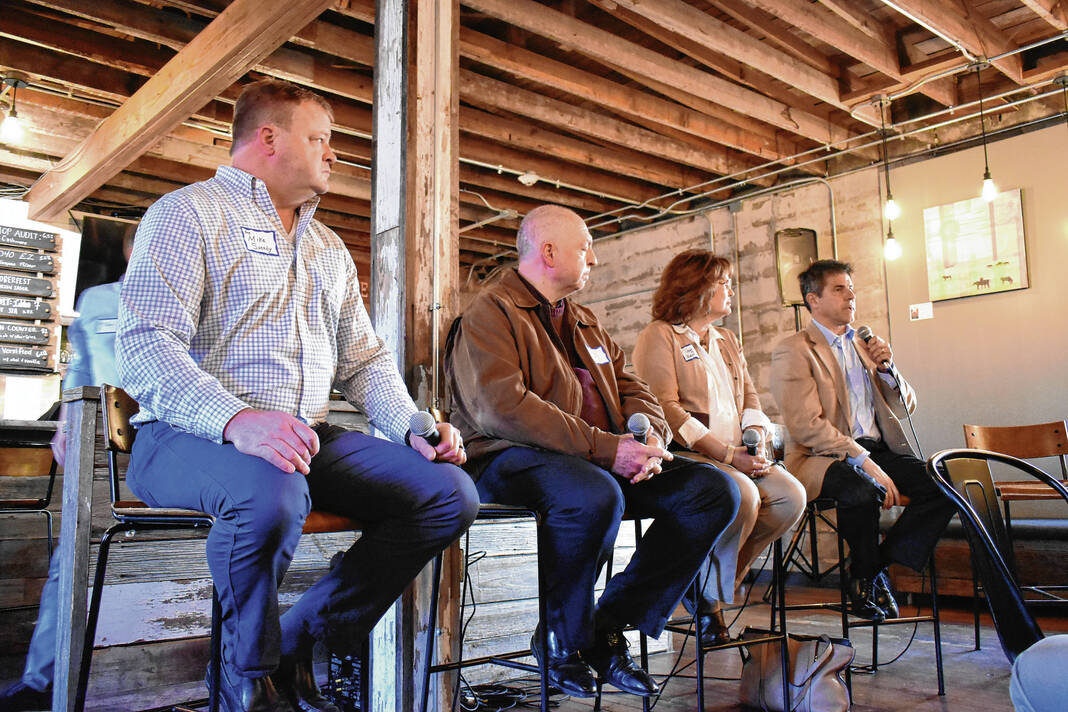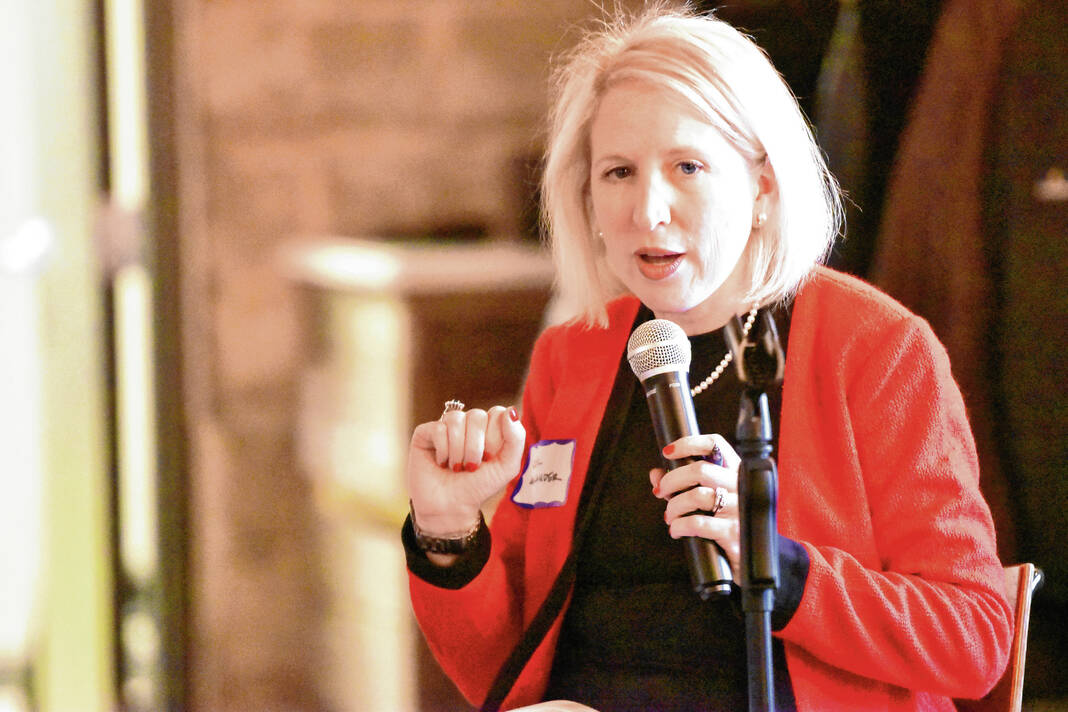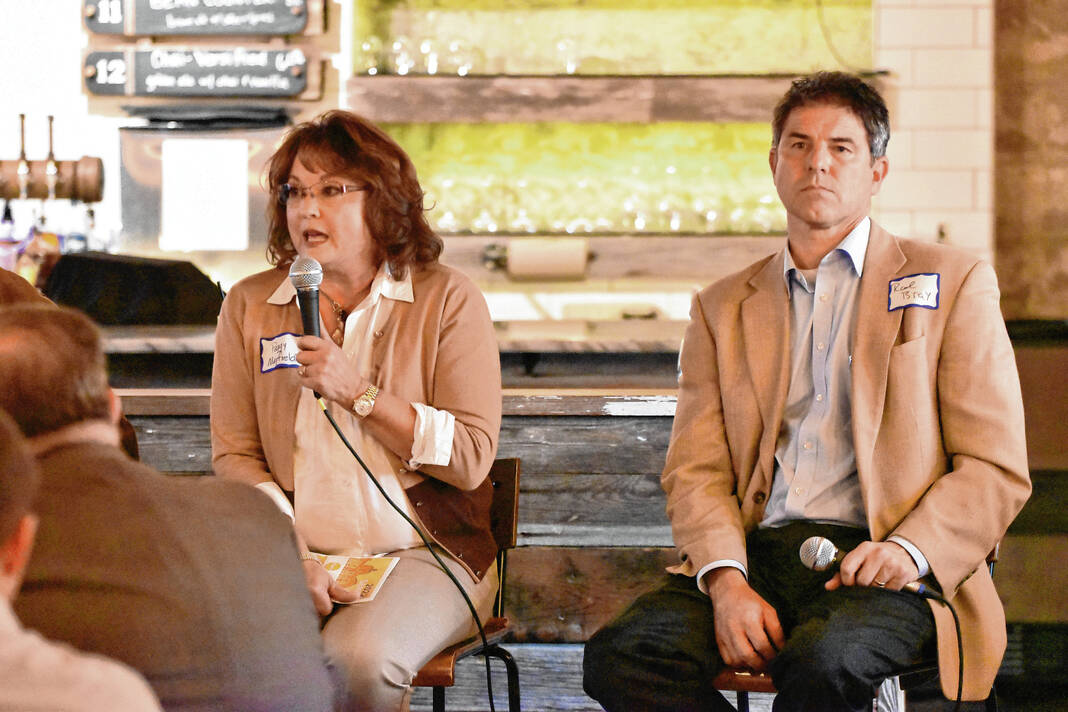
From left, State Rep. Mike Speedy, Sen. Greg Walker and Rep. Peggy Mayfield listen as Sen. Rod Bray speaks during an Aspire Johnson County Legislation Matters event Thursday at Taxman Brewing Company in Bargersville.
Noah Crenshaw | Daily Journal
Four state lawmakers previewed the upcoming legislative session during an Aspire Johnson County event Thursday.
State Reps. Peggy Mayfield and Mike Speedy, along with State Sens. Greg Walker and Rod Bray, were the featured speakers during Aspire Johnson County’s “Pints & Policy” Legislation Matters event Thursday night. This was the last Legislation Matters event of the year for the county’s chamber of commerce and took place at Taxman Brewing Company in Bargersville.
Before a question-and-answer session moderated by Caryl Auslander, a lobbyist who advocates for Aspire at the Indiana Statehouse, and Aspire President and CEO Christian Maslowski discussed the chamber’s priorities next session. The chamber will be advocating for attainable housing, early childhood education and free enterprise, he said.
Lawmakers then discussed the upcoming session and their priorities in the Q&A. Members of the audience also submitted questions during the event.
Inflation’s impact on the next budget
When lawmakers return to Indianapolis in January, they will be drafting the state’s next two-year budget. Auslander asked how inflation would impact the budget creation process.
Indiana currently has a $6 billion surplus, however, without even drafting a new budget, the surplus is expected to drop to $4 billion just from inflationary pressure, Rep. Peggy Mayfield, R-Martinsville, told business leaders.
Lawmakers want to keep at least $2 billion in reserve from the surplus. So, there is $2 billion lawmakers have to spend, and they plan to prioritize that for one-time capital expenditures, she said.
“$2 billion is a lot of money, but it ain’t $6 billion,” Mayfield said. “… We can’t necessarily put it in a structural budget where we have to fund it every year because we never know what our income is going to be, what our revenues will be in the future.”
Rep. Mike Speedy, R-Indianapolis, said a big reason why the surplus has grown so much is inflation. That’s because when the cost of an item increases, so does the sales tax, he said.
Another thing that has also gone up is property values, which in turn has caused an increase in property taxes. Speedy expects the Ways and Means committee to do something to tackle that, along with studying if the surplus could be used to pay state employees more.
Indiana’s role in providing child care
The panel also discussed the state’s role in providing quality and affordable child care to Hoosiers. Sen. Greg Walker, R-Columbus, was the first to speak as he and Auslander had previously worked together on child care issues.
Walker said lawmakers need to have a conversation about child care affordability because it is keeping people out of the workplace. Providing a direct subsidy to the industry or as a tax credit to those who need child care could be options, Walker said.
Another problem is attracting enough qualified professional people to watch children. Lawmakers need to work to address regulatory burdens to help with the issue, he said.
Walker also said lawmakers should consider raising caps on credits for those who are returning to school and are low income and trying to skill up. Increasing the caps could help attract more workers, he said.
“You can’t pay $11 an hour and get people to watch kids all day,” Walker said. “It’s strictly difficult, challenging and rewarding work, and it’s worth more than $11 an hour.”
While Senate President Pro Tem Rod Bray, R-Martinsville, agrees with Walker the issue should be addressed, he doesn’t know if subsidies are the right answer. Once the state begins doing that, the subsidies don’t get smaller, he said.
“We have to be really, really aware of what we’re doing,” Bray said.
There has to be a role for private industry in addressing the issue. Legislators also have to figure out the roles of both the state and private industries, Bray said.
Mayfield said legislators have passed so many laws aimed at protecting the child and making sure child care workers are safe around children. However, it’s a matter of balancing this with paying workers enough to watch children, she said.
Addressing the need for more housing
Another topic legislators discussed was housing issues and how the state could address them. Mayfield knows of one company — Cook Medical — that is tackling the issue head-on by building houses for their employees, she said.
“They’re building the neighborhood and they are selling them to their employees,” Mayfield said. “They’re not waiting for someone else to do it. They did the same thing with education.”
Removing obstacles could also help. For example, if a local government requires brick on three sides of a home, it drives up the cost, Mayfield said.
“If they’re aesthetic, they’re not code,” she said. “So do we need to limit what a local government can require in a development after those neighborhoods have been platted?”
Walker believes officials should continue to find creative ways to make more space. In Bartholomew County and Columbus, the biggest investment in development has been multiple-floor buildings and re-purposing an old foundry, he said.
He also struggles with the physical limitations of adding more housing, such as getting past skyrocketing building supply costs.
Tackling the state’s disproportionate health care costs
The last topic lawmakers discussed was addressing the state’s health care costs. A recent study has revealed the state has disproportionately high health care costs.
Walker said the state has been challenging hospitals to be more transparent about why the costs are where they are. Right now everyone — insurance, providers and others in the chain — are pointing the finger at each other about what could be done, he said.
“This is is probably the hardest question I’ve had, short of the abortion bill, the whole time I’ve been in the General Assembly,” Walker said.
A few years ago, lawmakers worked hard to put provisions in place to add more transparency to the cost process. Indiana’s hospitals are high quality, and legislators need to ensure future transparency and economic efforts don’t mess this up, Bray said.
“We’ll continue to work on those things,” he said. “There are some other things that we’re trying to work on right now, some of those come with a good bit of controversy and create a lot of turmoil.”
Lawmakers need to get all of the stakeholders into the same room so they can have a constructive conversation about what the future changes could look like, he said.
Whatever legislators do to help address the situation it should be incremental, Mayfield said. A couple of years ago, the focus was on transparency, and she believes this time they will focus on controlling costs. It’s just a matter of getting those on the health care, insurance and patient sides together, she said.











